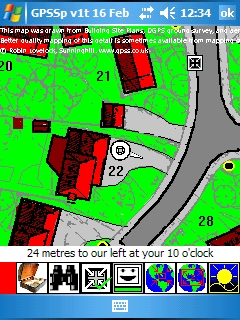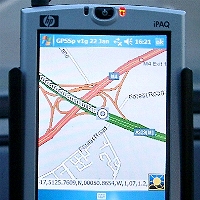







Home
GPS
Download
Business
Partners
Contact
Family
AVL
Links
History
AsOnTV
GPS Software on Pocket PC, Smartphone and iPAQ
- details on GPSSp, the earlier NSBasic version
Updated 1200 Sunday 13th August 2006
 In August 2006, as part of a general "tidy-up", I moved information related to GPSSp, our
older NSBasic version of GPSS for the Pocket PC, onto this page.
People should now start by using GPSSppc, written in VB.Net, and
consult the
GPSS on Pocket PC page.
In August 2006, as part of a general "tidy-up", I moved information related to GPSSp, our
older NSBasic version of GPSS for the Pocket PC, onto this page.
People should now start by using GPSSppc, written in VB.Net, and
consult the
GPSS on Pocket PC page.
You should not need to use this old GPSSp.
Robin Lovelock, Sunninghill UK, March 2007.
old information from August 2006 follows ...
GPSS for the Pocket PC - old GPSSp ...

The information below and the download of Robin's "GPSS on Pocket PC" is for those
already in direct contact with Robin.
They will need a Pocket PC on which to test the program
and ideally should already have GPSS, the GPS Software, running on a full Windows Laptop PC
with a GPS connected. They will therefore already be familiar with how GPSS files are distributed.
The process below is NOT a simple Pocket PC install.
Please follow the instructions carefully.
Here are the steps if you want to try the earlier NSBasic GPSSp.exe, instead of GPSSppc.exe.
Most people will NOT need this.
- create a folder on your desktop PC for gpssp.exe and it's files. When ready, this will be activesynced to the Pocket PC. e.g. \gpssp
- have your iPAQ/Pocket PC connected to this desktop PC with Activesync running.
- run RuntimeFat.ppc.exe or alternative from
www.nsbasic.com/ce/support/downloads.html
to instal NSBasic onto your Pocket PC.
- download the gpssp baseline from
www.gpss.co.uk/ce/gpssbase.exe - SAVE gpssbase.exe into the desktop folder but DO NOT RUN yet.
- download the latest gpssp.exe from
www.gpss.co.uk/ce/gpssp.exe
into the same folder on the desktop PC.
- Run gpssbase.exe in the desktop PC folder to self-extract the baseline files. These include some maps and sounds.
- You may now delete gpssbase.exe from the desktop PC folder because it is not needed in the iPAQ.
- Activesync this folder of files from your desktop PC to your Pocket PC. e.g. \gpssp
- use file explorer or a shortcut to run \gpssp\gpssp.exe on the Pocket PC.
It should work as in the "very brief user guide" above.
- if gpssp all works, including with the GPS, you can add more GPSS mapping for your country.
See "test in simple steps" below.
I understand that peculiarities of the CE/NSBasic system may require use of start-settings-system-Remove Programs to be
followed by a soft reset (poking the stylus into the hole in the side). This might be typically done when
you decide to try some other combination of NSBasic runtime. e.g. you were using Runtime.ppc.exe and you
now want to try RuntimeFAT.ppc.exe.
YOU DO ALL THIS AT YOUR OWN RISK.
Having warned you, I'm new to iPAQs, have used the reset procedure several times, and have not
experienced a problem... yet :-)
old information: change history for gpssp.exe ...
 This may make more sense to those who have run GPSS on a full Windows desktop or laptop,
but here
is a brief summary of what the uploaded gpssp.exe version 1 can do:
This may make more sense to those who have run GPSS on a full Windows desktop or laptop,
but here
is a brief summary of what the uploaded gpssp.exe version 1 can do:
- startup with Sunninghill logo, title and sounds, working in 240x320 Portrait or 320x240 Landscape modes.
- use most of the maps for 155 countries off www.gpss.co.uk. Not yet the USA vector mapping.
- use GPSS maps from
google earth and AutoRoute/Trips
for Japan or those you've
made yourself.
- allow browsing of the maps by tapping on the screen.
- respond to a GPS by automatically selecting the best map and updating the car icon.
- continue to change map and track the car as you move.
- show a trail of history points behind the car - a "breadcrumb trail" - see us testing version 1g on right.
- make use of the GPS speed and course information. e.g. pointer on the car icon.
- handle UK grid and UK grid based maps such as ASCOT in the GPSS Baseline.
- automatically speak position based on WAW files. e.g. "we are 25 miles west of London and in Sunninghill"
- handle a destination and guidance to it via display and voice. e.g. "destination 230 yards ahead, at your 1 o'clock"
- work with any GPS including bluetooth: not just NMEA on COM1. Can use GPSGate if not COM1. v1n.
- support for recording and playback/plotting/analysis of recorded GPS data as
NME files. Sample newtrip.nme included in baseline. v1o.
- support for km/metres and nautical miles via METRIC.CFG or NAUTICAL.CFG. Lat/LOn display. v1p.
- "we are near destination". Automatic warning of speed traps, as on speed page.
6 for test with [>] in gpsbaseline. 6000 Limit. v1q.
- search for places of interest as destinations: use of free UK data such as "Interesting Places", and
Geocaches. v1r.
- repeated searches: "the next nearest" etc. Status lamp. DISPLAY.TXT option. e.g. 240x240. v1s.
- saves startup image in SCREEN0.BMP. Tapping low left of screen saves into SCREEN.BMP for rename and email to Robin. v1t.
- minor bug fixes and tuning related to speaking, near destination and speed trap logic, etc. v1u 22 Feb 06.
- Irish grid. more error trapping. experiments on VEC files. v1v 2 March 06.
- Maximum number of maps raised from 100 to 300. Warning if more. v1w 7 March 06.
- "GG" UK maps. THURAYA.CFG for Thuraya. GPSSDIAL.CFG
for test. DTR high is default. v1x 12 March 06.
- remote tracking working for two targets. Supports gpssdial.cfg and contact.cfg.
See remote tracking for details. v1y 15 March 06.
- Control of [OK] or [X]. More error trapping. v1za 22 March 06.
- [HOME] from GPSS.CFG. Speedtrap 75m+10s. Every history point if map < 1 mile, else 1 minute. v1zb 29 March 06.
The full Windows version of GPSS has obviously done most of the above, and much more, for many years: hence the rapid progress ;-)
old "want to help Robin ?" information, talking about GPSSp
- beta testing: tell Robin whether you can, or can't, run this gpssp.exe, built using NSBasic, on your Pocket PC, and if it works with the GPS.
This includes help in finding out what NSBasic/CE runtime files are needed to make gpssp.exe run on your particular CE device.
The
NSBasic Forum is relevant.
So is
NSBasic TN33.
Please do NOT email NSBasic for support
because they are only there to help software developers who purchased the NSBasic product,
and not end-users. However, their web site may help.


 In August 2006, as part of a general "tidy-up", I moved information related to GPSSp, our
older NSBasic version of GPSS for the Pocket PC, onto this page.
People should now start by using GPSSppc, written in VB.Net, and
consult the
GPSS on Pocket PC page.
In August 2006, as part of a general "tidy-up", I moved information related to GPSSp, our
older NSBasic version of GPSS for the Pocket PC, onto this page.
People should now start by using GPSSppc, written in VB.Net, and
consult the
GPSS on Pocket PC page.

 This may make more sense to those who have run GPSS on a full Windows desktop or laptop,
but here
is a brief summary of what the uploaded gpssp.exe version 1 can do:
This may make more sense to those who have run GPSS on a full Windows desktop or laptop,
but here
is a brief summary of what the uploaded gpssp.exe version 1 can do: